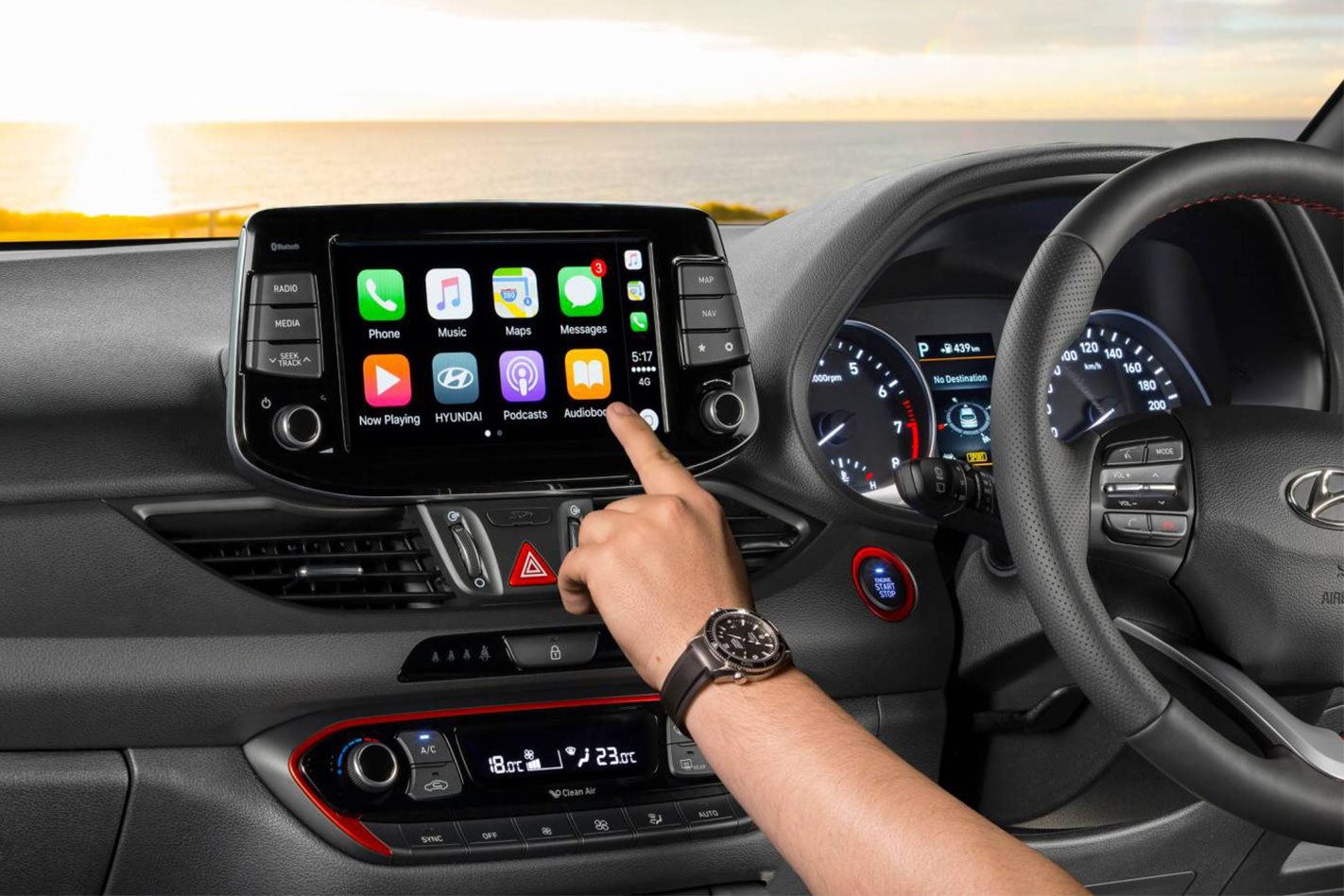
As Australians become more and more connected, infotainment systems are an important battleground for carmakers as they strive to give customers larger screens, more useful apps and better integration with their smartphones.
Merging the functions of satellite navigation, vehicle settings and telephony (information) with radio, CD/DVD, audio streaming and internet connectivity (entertainment), colour touchscreens are fast becoming standard equipment, even in affordable hatchbacks, and offer tremendous levels of functionality for both drivers and passengers.
But they’re not all created equal. Here’s the WhichCar guide to the infotainment systems you’ll find in the small car segment’s top-selling vehicles:
TOYOTA COROLLA
Overview
Let’s start with the segment-leader, the sales king of the small car segment. Toyota’s evergreen Corolla has consistently been one of Australia’s most popular cars, but as the model enters its fifth year on the market it’s also one of the oldest models in this segment. So it’s no surprise that its infotainment package lacks the cutting-edge sparkle of some of its competitors.
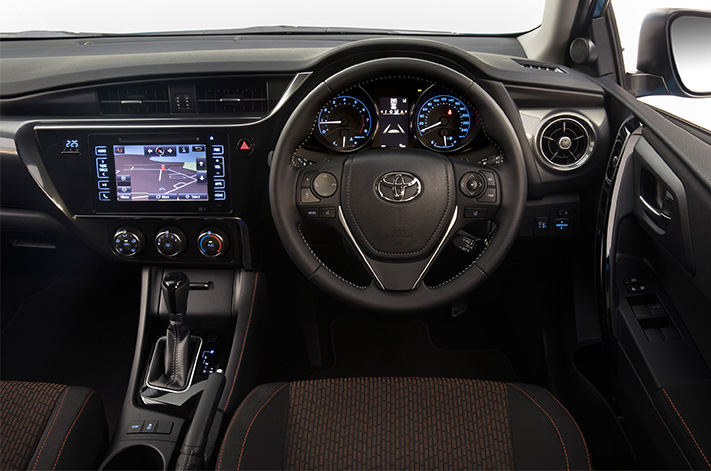
Audio
A 6.1-inch colour touchscreen headunit is standard on the base Ascent hatch, with all other models receiving a 7.0-inch screen. All Corolla models pipe sound through six speakers, with AM/FM radio and a CD player being built-in. A USB input also allows music to be played from a removable flash drive, or phone/portable music player.
Smartphone connectivity
The Corolla range lacks any smartphone mirroring capability, but there is a suite of internet-enabled apps available via Toyota’s own ‘Toyota Link’ system. It uses your phone’s data connection to source weather, destination and fuel station information, and can stream music via Pandora.
Beyond that, all Corollas come standard with Bluetooth phone and audio connectivity.
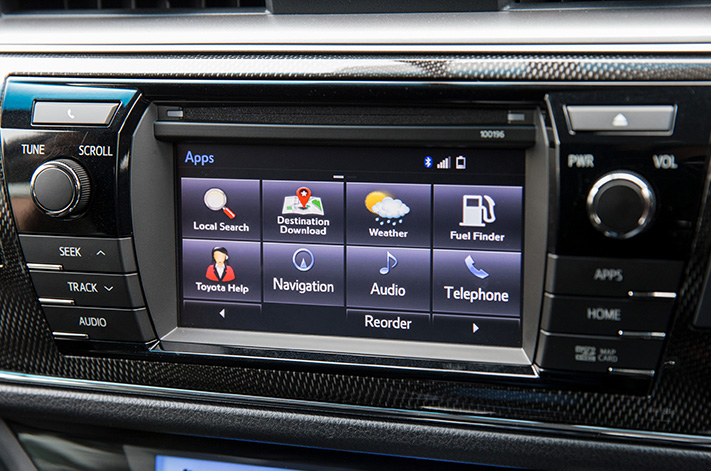
Satellite navigation
Satellite navigation isn’t available in the base Corolla Ascent hatch and sedan, and is a cost option on the Ascent Sport. All other variants feature satellite navigation as standard, though the graphics and interface looks old and can be clunky to operate, with slow responses to destination input via the on-screen keyboard.
Other features
A reversing camera is standard-issue for the Corolla, and is displayed on the infotainment system’s screen.
SCORE: 5/10 – All of the basic features are there, but Toyota hasn’t kept pace with advances in infotainment tech with running updates to the Corolla. On top of that, there’s no smartphone mirroring tech to provide a more up-to-date software alternative.
HYUNDAI i30
Overview
The Hyundai i30 is another segment-leader and, unlike the Toyota Corolla, one of the fresher products. With an all-new European-style model having launched recently, the i30’s infotainment package is very much up-to-date in terms of its feature set.
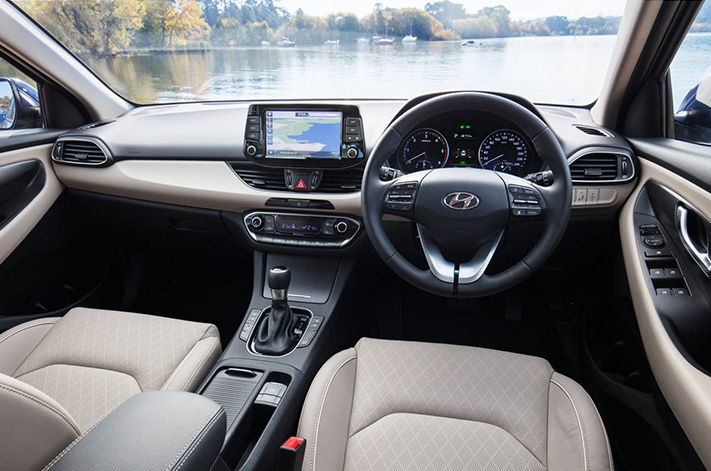
Audio
Six-speaker audio with AM/FM radio tuner and DAB+ digital radio is standard-fit for the i30 family, with a 3.5mm aux input, USB port and Bluetooth audio streaming allowing music and podcasts to be played from your phone or portable media player.
A CD/DVD player is not fitted to any i30 variant, but all models are equipped with a sizable 8-inch colour touchscreen that’s located high on the centre console to keep it within the driver’s eye-line.
Smartphone connectivity
Android Auto and Apple CarPlay smartphone mirroring is standard across the full i30 range. Bluetooth tethering is also standard, and covers both basic phone functions as well as music streaming.
Satellite navigation
The i30’s sat nav screen may look a little ordinary in terms of graphical presentation, but the touchscreen surface responds quickly and faithfully even to light finger presses. Entering destinations via the on-screen keyboard is easy and fast, an attribute which isn’t all that common in this segment.
Live traffic updates are also available via the SUNA system, enabling the i30 to re-route your path in the event of heavy traffic. The best part? All i30 models get sat nav as standard.
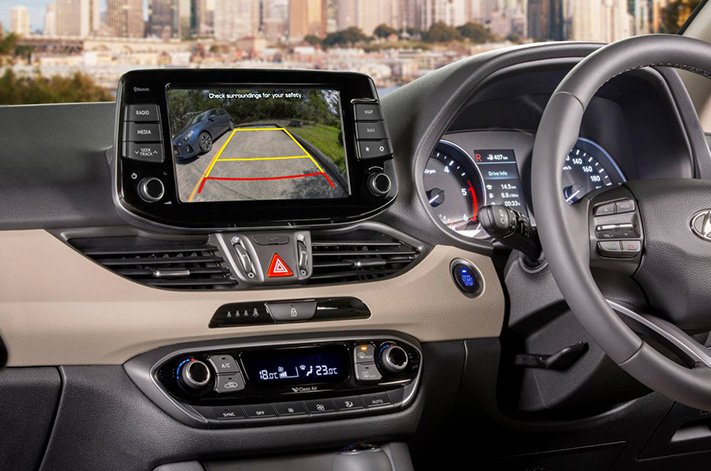
Other features
Wireless phone charging is standard on all variants bar the base i30 Active. All other i30 models feature an integrated charging pad at the base of the centre stack. If your phone has a wireless charging capability that adheres to the Qi standard, all you need to do is place it on top of the pad and it will start topping up its battery without any cables.
A trip computer is inset between the speedometer and rev counter, and is a 3.5-inch monochrome display in the base i30 Active and a 4.2-inch colour display in the Elite, Premium, SR and SR Premium grades.
All i30 models come standard with a colour reversing camera, which displays on the infotainment screen and features dynamic guide lines to show you where the vehicle will travel when reversing.
SCORE: 8/10 – Basic graphics aside, the i30’s infotainment package is neat, intuitive to use, highly responsive and feature-rich. With a high-mounted screen, it should also see fewer drivers get distracted as they consult the map or change radio stations. Having digital radio, satellite navigation, wireless charging and smartphone mirroring as range-wide equipment are all huge plusses.
MAZDA 3
Overview
Mazda’s popular 3 had one of the most impressive and sophisticated infotainment systems in the mainstream small car segment when it launched, and even though it’s now halfway through its lifecycle the Mazda 3’s “MZD Connect” infotainment package still boasts a premium look and feel.
With a rotary dial located on the centre console giving users an option to the usual touchscreen method of input and interaction, the MZD Connect hardware looks like it belongs – or was taken from – a luxury car. However, there’s a catch – not every Mazda 3 model gets it.
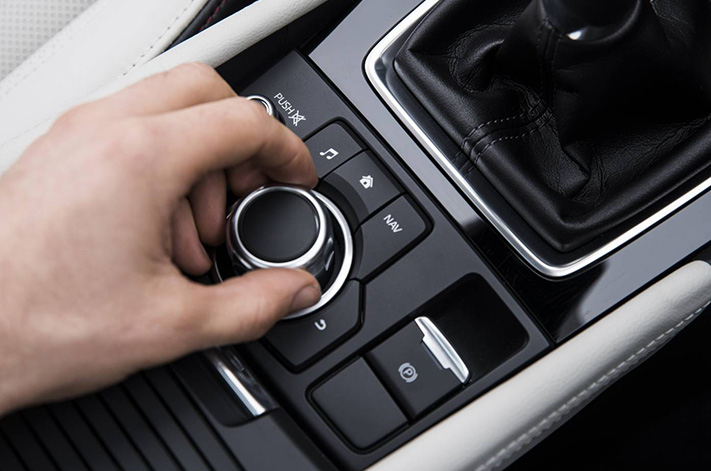
Audio
The entry-level Mazda 3 Neo comes with a basic audio system with four speakers, USB/aux inputs, steering wheel controls, an AM/FM radio and monochrome LCD screen.
Far from cutting edge, but the good news is every other model in the range gets a significant lift in the infotainment stakes. From the Maxx grade and up, the Mazda3 is equipped with the MZD Connect system, bringing a 7-inch colour touchscreen, remote control interface, digital radio tuner, and an extra two speakers over and above what the base Neo offers.
A premium Bose audio system also offers a total of 9 speakers and a 231-watt amplifier.
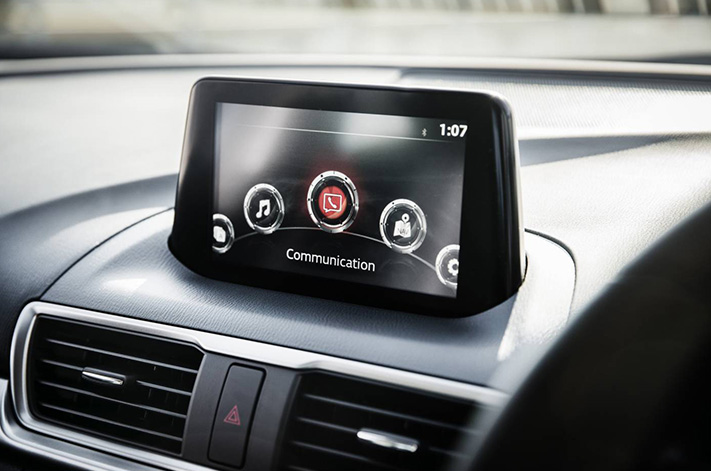
Smartphone connectivity
All Mazda 3s feature Bluetooth phone and audio integration as standard, however there’s no provision for smartphone mirroring in any variant.
Internet connectivity via your phone’s data connection does allow music streaming apps like Pandora, Stitcher and Aha to be used, however.
Satellite navigation
Satellite navigation is standard on the Maxx grade upwards, but there’s no capacity for integrated sat-nav in the base Neo (below) thanks to the absence of both smartphone mirroring and a proper multifunction screen.

Other features
A colour head up display in SP25 GT and SP25 Astina grades projects vital vehicle info such as speed, cruise control settings and turn-by-turn satellite navigation instructions onto a transparent screen between the windscreen and the driver’s eyes. As a device that allows the driver to keep tabs on key info without taking their eyes away from the road ahead, it’s a very useful feature.
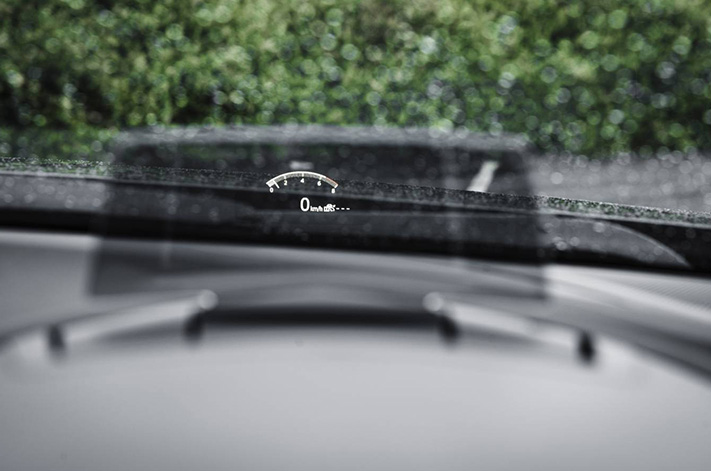
A reversing camera is standard on the Maxx grade upwards.
SCORE: 6/10 – Mazda’s MZD Connect system has a lot of showroom wow factor, and is beautifully integrated into the 3’s interior. However, putting a basic touchscreen-less headunit into the base model and not enabling smartphone mirroring for any variant sees it lose points.
We’ve also experienced more than a few issues over the years with Mazda’s system, with the MZD Connect system spontaneously freezing up or rebooting itself while in operation.
Overview
The Kia Cerato’s infotainment package follows a similar structure to the Mazda 3, with entry-level grades receiving a primitive (by current-day standards) headunit in the entry-level model and a more high-featured system in all other grades.
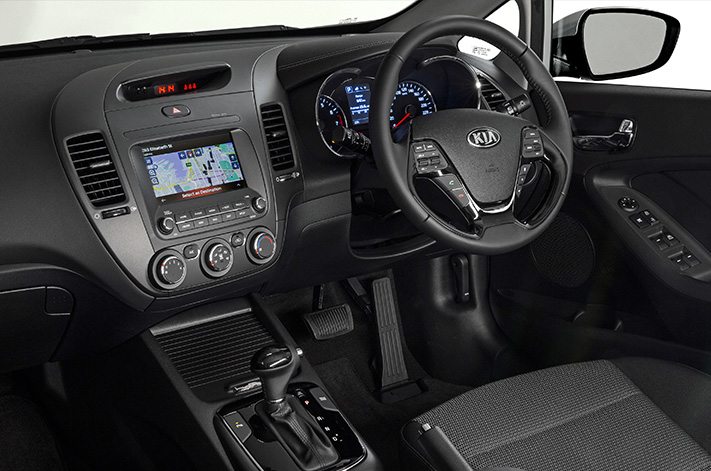
Audio
In the base Cerato S, Kia’s small car offering is equipped with a basic AM/FM/CD audio system with six speakers , USB/3.5mm auxiliary inputs and a monochrome LCD screen as standard.
However, move up to the S Premium, Sport, Si or SLI grades and you gain a more full-featured headunit with a 7.0-inch colour touchscreen interface. It’s a slicker piece of hardware, though there is a trade-off – getting the higher-end infotainment package means sacrificing the CD player.
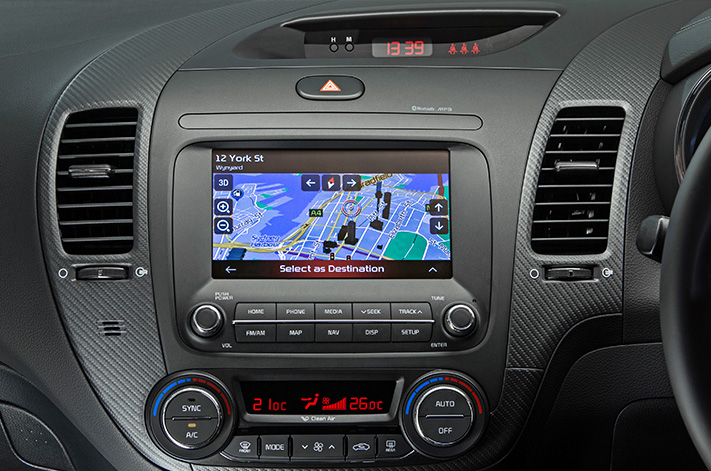
Smartphone connectivity
All models allow your phone to be tethered via Bluetooth for audio streaming and phone functions, however only the models with a 7.0-inch colour display allow smartphone mirroring via Android Auto and Apple CarPlay as well.
Satellite navigation
Built-in sat-nav is available in the S model if you option in the AV accessory pack (which replaces the S’ basic headunit with the 7.0-inch screen), but is standard in all other variants. The interface is basic, slow to react and graphically unimpressive, but a more up-to-date alternative in the form of Apple Maps or Google Maps is available if you exploit the smartphone mirroring feature that’s built into those models.
SUNA live traffic updates are also available on models equipped with the 7.0-inch display.
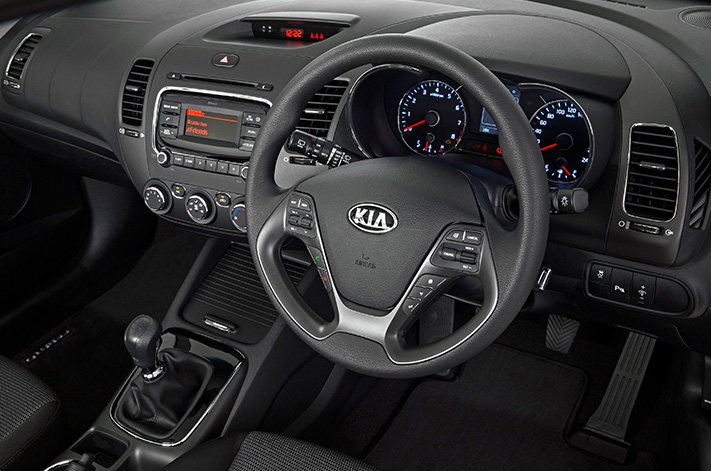
Other features
A reversing camera is standard on those models equipped with the 7.0-inch touchscreen display.
SCORE: 5/10 – The Cerato earns the same score as the Corolla despite only equipping higher-grade models with a touchscreen display, mainly because its smartphone mirroring capability in those models enables users to get around the Cerato’s somewhat antiquated sat-nav interface.
If you like playing CDs though, subtract a point from this score as Kia will only allow you to slot a disc into the Cerato’s dash if you buy a base model.
Volkswagen Golf
Overview
The newest, and by far the most feature-rich and visually impressive system in this article, belongs to the Volkswagen Golf. Available in three guises, the entry-level “Composition Media” infotainment system is built around an 8.0-inch colour touchscreen and is standard in base Golf and Golf Trendline grades.
A sat-nav enabled “Discover Media” system becomes standard in Comfortline and Highline models and also uses an 8.0-inch display, while a cost-optional “Discover Pro” package brings a slick 9.2-inch touchscreen with additional features.
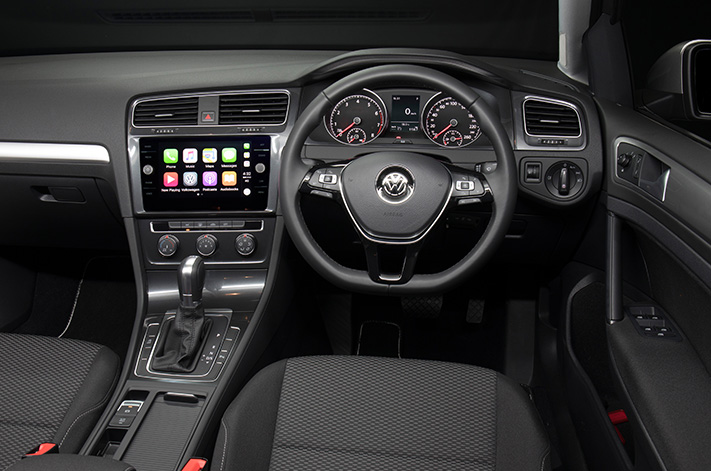
Audio
All Golf models get 8 speakers as standard, with all three variants of the Golf’s infotainment system boasting AM/FM radio, USB audio input, a CD player and an SD card slot. The Discover Media and Discover Pro systems bring an extra SD card slot,
Smartphone connectivity
Every Golf allows smartphone mirroring via Apple CarPlay and Android Auto, along with the virtually universal Bluetooth telephony and audio connectivity.
The Golf 7.5 goes a little further, however. Download a VW app and you can also use your phone as a remote control for the infotainment system, meaning you can change the music, interact with the sat-nav and more from the back seat – if you really want.
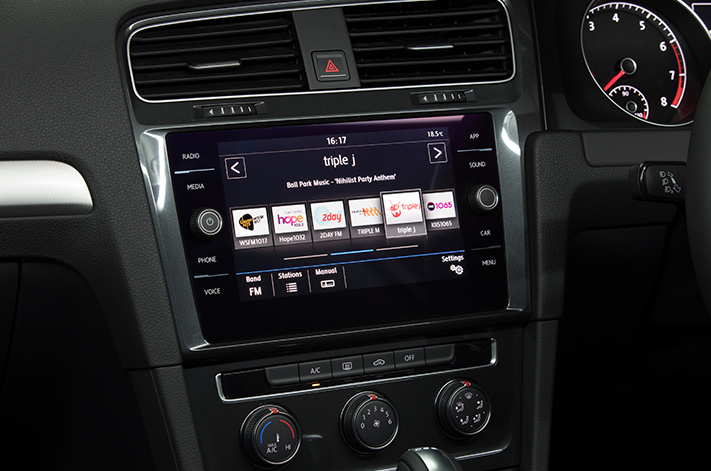
Satellite navigation
The base Composition Media system in the entry-level Golf and Golf Trendline doesn’t have a built-in satellite navigation capability, but the standard smartphone mirroring does at least allow you to get around that by plugging in your mobile.
All other models feature satellite navigation as standard, and the Golf’s smartphone-style screen with its fast touch responses and pinch-to-zoom capability makes it especially easy to use. Graphics are crisp and clear, and turn-by-turn instructions are repeated on the trip computer display within the instrument panel.
Other features
Pay extra for the Golf’s “Infotainment Package” (which is only available on Comfortline and Highline variants) and you gain an all-electronic instrument panel for a bit of Audi-style magic. It replaces the traditional instrument cluster with a 12.3-inch reconfigurable TFT screen, with bright and clear graphics and a plethora of display options.
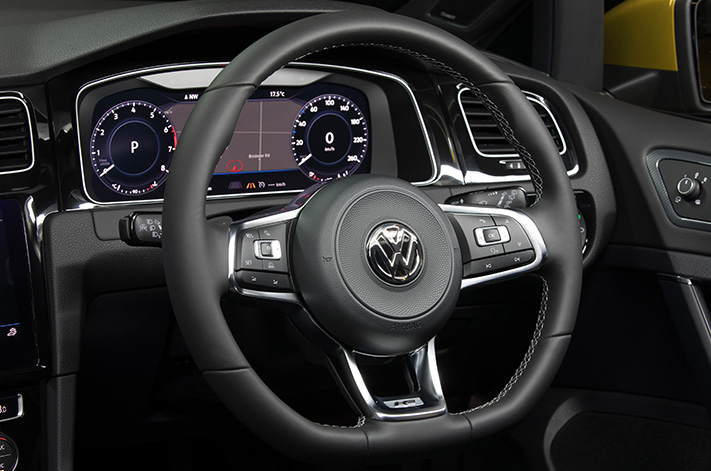
You’ll also get the high-end 9.2-inch infotainment screen, along with the ability to interact with the system by making gestures in front of the screen.
There are also performance functions hidden within the standard infotainment system, with a Lap timer, G-meter and other performance-oriented displays. They may seem more appropriate for a Golf GTI or a Golf R, but you’ll get them on a regular Golf regardless.
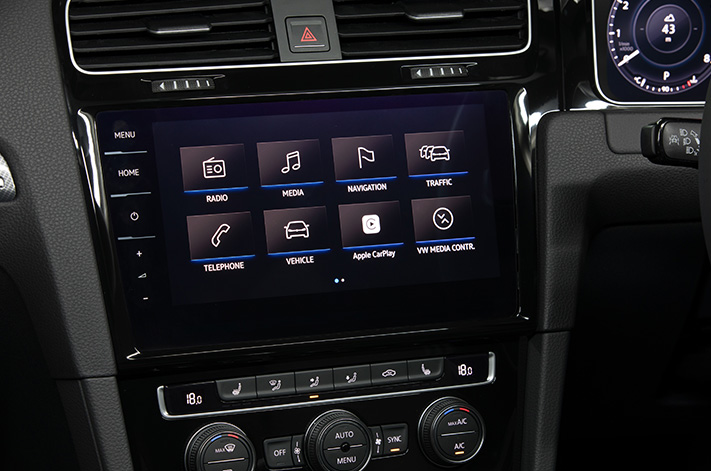
You can also view JPEG images loaded via the SD card slot, if you wish, while the Discover Media system brings voice commands for those who prefer not to press buttons or prod screens for simple operations. All models display the reversing camera on the central screen, along with parking sensor info.
SCORE: 9/10 – For its slick presentation, feature count and ease of use, the Volkswagen Golf easily boasts the most impressive infotainment package in its segment. Even though low-grade models miss out on sat-nav, Android Auto and Apple CarPlay still allow nav info to be shown on the Golf’s almost tablet-like high-resolution screen.
Step up into high-grade models – or option the Infotainment Package – and the Golf’s in-car tech becomes properly premium. Only the addition of digital radio and a wireless charging pad could see its score rise to a perfect 10.



